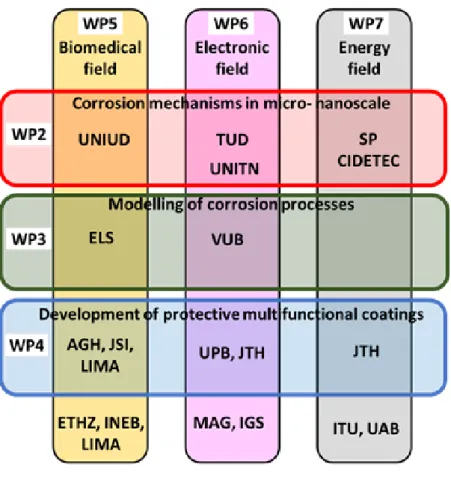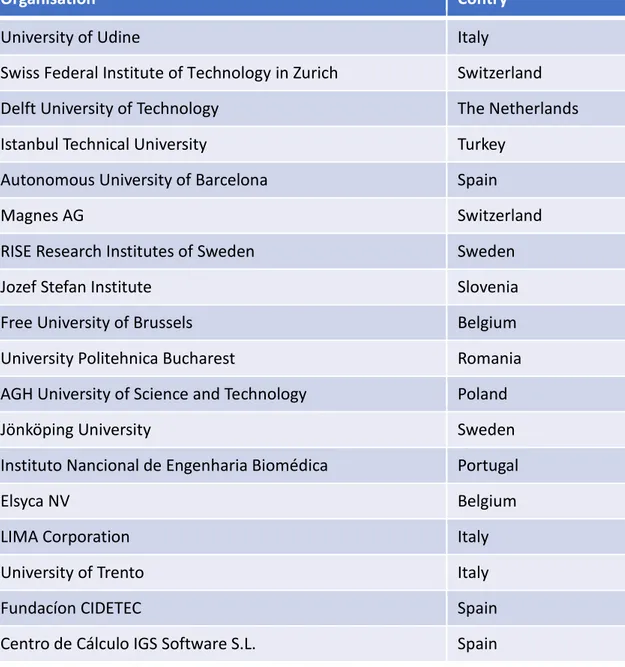http://www.diva-portal.org
Postprint
This is the accepted version of a paper published in Transactions of the Institute of Metal Finishing. This paper has been peer-reviewed but does not include the final publisher proof-corrections or journal pagination.
Citation for the original published paper (version of record): Lekka, M., Zanella, C., Leisner, P. (2017)
New European Training Network solving corrosion problems on micro- and nanoscale: mCBEEs
Transactions of the Institute of Metal Finishing, 95(6): 297-298 https://doi.org/10.1080/00202967.2017.1375186
Access to the published version may require subscription. N.B. When citing this work, cite the original published paper.
Permanent link to this version:
1
New European Training Network solving corrosion problems on micro-and
nanoscale: mCBEEs
Maria Lekka, University of Udine, Udine, Italy
Caterina Zanella, Jönköping University, Jönköping, Sweden Peter Leisner, RISE Research Institutes of Sweden, Borås, Sweden
mCBEEs is an acronym for: Advanced integrative solutions to Corrosion problems beyond micro-scale: toward long-term durability of miniaturized Biomedical, Electronic and Energy systems. It is a doctoral student training network funded by the European Commission under the Marie Sklodowska-Curie Action scheme in the same way as the recently reported training network SELECTA that is focusing on smart electrodeposited alloys for environmentally sustainable applications [1].
mCBEEs is a joint venture between academy and industry embracing an interdisciplinary agenda focused on the assessment and solution of corrosion issues in small-scale components. The aim is to prepare the next generation of corrosion scientists by dedicated training through a cooperative research programme. The motivation for initiating mCBEEs is thecontinued growth in the use of miniaturized devices in many industrial sectors e.g. electronics, telecom and biotechnology. Device miniaturization is also impacting other front-line research and technology fields such as energy storage and renewables, and automotive industry. Indeed, micro- and nanoelectromechanical systems (MEMS and NEMS) and other small architectures are becoming increasingly ubiquitous as sensors, actuators, or structural and packaging elements. However, important and very often overlooked issues in miniaturized devices are corrosion effects derived from interaction between different materials, or from the
combination of several manufacturing steps. These interactions might cause severe damage and failure to micro- and nanomachinary, thus affecting their performance even in the short run. It is imperative that any selected material employed in miniaturized structures must be stable against corrosion. Slowly developing corrosion and minor surface defects that often are accepted as harmless for bulk materials in macrostructures, will most likely be problematic for micro- and nanoscale devices.
Materials used in micro- and nanodevices are chosen for their property-application-performance relationship rather than their corrosion reliability as one of the main criteria. Many field failure returns in e.g. electronics or biomedical applications are often attributed to
2
corrosion phenomena in tiny components such as galvanic corrosion, electrochemical migration or bias-induced corrosion. However, as failure sources are not thoroughly investigated, there is a significant amount of failed items, which are replaced rather than providing countermeasures.
During the last two decades numerous of localized techniques have been developed to investigate corrosion on microscale, e.g Scanning Vibrating Electrode Technique (SVET), Kelvin Probe Force Microscopy (KPFM), Localized Electrochemical Impedance
Spectroscopy (LEIS), Scanning Electrochemical Microscopy (SECM) and Electrochemical Microcell. However, their use has mainly focused on investigation of corrosion mechanisms at macroscale. Representative examples are the evaluation of the influence of intermetallics in corrosion of alloys, the identification of anodic and cathodic sites, and the effect of micro- and nanodefects on protective coatings [3-6]. Instead, corrosion processes in nanoparticles [7-8], nanowires [[7-8], and other microstructures [9] are rarely considered, and most of the studies are limited to investigate the degradation and the corrosion products.
Corrosion phenomena occurring in micro- and nanodimensional structures can develop in a completely different path than in their bulk counterparts. It is widely unexplored how the shape of small scale structures influences the corrosion. Certain geometries can critically favour corrosion processes (e.g. crevices), which have not yet been clearly defined for small scales, and whose mechanisms remain unknown at such dimensions. It has recently been highlighted that corrosion is the main restriction for many nanotechnology applications [10]. mCBEEs will focus its efforts in developing protective strategies suitable for micro- and nanoarchitectures without compromising their functionality. Three main application fields have been identified as areas where corrosion could heavily influence the performance of micro- and nanodevices:
A) Biotechnology: Human body fluids and tissues are corrosive environments because of their oxygenated saline environments. Corrosive species include inorganic ions, coordination compounds and biomolecules, which can accelerate corrosion due to their complexing and chelating effects, or trigger biofouling corrosion [11].
Understanding corrosion mechanisms at micro- and nanoscales in bioenvironments is crucial to design multifunctional implants.
B) Electronics: Sensors, actuators, structural and packaging building blocks can be exposed to various corrosive application environments. A broad mixture of metals, alloys, semiconductors, ceramics and polymers are used in miniaturized systems. Micro- and nanosized components and thin films could undergo fast degradation due
3
to galvanic coupling, crevice corrosion or even uniform corrosion in highly moisturized environments, which could serious compromise device performance. C) Energy: During the last decade, electric energy storage media and systems for
electrochemical energy conversion (e.g. batteries, supercapacitors and fuel cells) have been considerably improved in terms of their capacity and efficiency thanks to
significant developments of electrodes, including micro- and nanostructuring and material-doping. As electrodes must be catalytically active, they are highly sensitive to pollution, and therefore prone to degradation. Additionally, the demanding internal environment (e.g. chemistry and temperature) in electrochemical energy conversion systems poses complex challenges in terms of durability, which even could
compromise the safety of energy storage media.
The research activities within mCBEEs focus on three generic tasks:
1) Study of corrosion phenomena and mechanisms at micro- and nanoscales in different corrosive environments and applications fields,
2) Development of advanced electro-chemical models for corrosion at microscale, 3) Design and integration of protective strategies and measures on small components.
mCBEEs is organized in six work packages each having a specific research objective. The work packages are representing the three application fields (A-C above) and the three generic tasks (1-3 above). The application fields are integrated with the generic tasks by a matrix as illustrated in Figure 1. In this way the enrolled PhD students will be involved in research related to both a generic task and an application field.
4 Figure 1
Figure 1: Interaction between the six research work packages within mCBEEs.
mCBBEs are in the process of recruiting in total 15 PhD students for 15 host organization located in ten different European countries (Belgium, The Netherlands, Italy, Poland,
Romania, Slovenia, Spain, Sweden, Switzerland, Turkey). Additional three organizations are participating as hosts for secondments as a part of the training. All partner organizations are listed in Table 1.
mCBEEs are providing the highest level of research education within the scope of corrosion mechanisms at the micro- and nanoscale, which no single partner in the network can provide on its own. Therefore, mCBEEs provides an integrated, highly cooperative, interdisciplinary and inter-sectorial research environment. The PhD students will take part in several
Secondments at partner organisations for complementary training, summarizing to between five and eight months for each PhD student. Furthermore, the programme contains three one-week training schools and two workshops as scheduled common activities enhancing the
5
training quality and support networking. Additional networking and dissemination activities will also take place. Some of these will be in cooperation with the European Federation of Corrosion (EFC) and the European Academy for Surface technology (EAST).
In order to strengthen cross-border networking, PhD students are recruited to partners in other countries than where they are active at present.
The coordinator of mCBEEs is dr. Maria Lekka at University of Udine, Italy, and the training manager is prof. Caterina Zanella, Jönköping University, Sweden.
More information of this European Training Network including details on the recruitment procedure for PhD students and information on the individual PhD projects can be found at: www.mcbees.eu
Organisation Contry
University of Udine Italy
Swiss Federal Institute of Technology in Zurich Switzerland Delft University of Technology The Netherlands Istanbul Technical University Turkey
Autonomous University of Barcelona Spain
Magnes AG Switzerland
RISE Research Institutes of Sweden Sweden
Jozef Stefan Institute Slovenia
Free University of Brussels Belgium University Politehnica Bucharest Romania AGH University of Science and Technology Poland
Jönköping University Sweden
Instituto Nancional de Engenharia Biomédica Portugal
Elsyca NV Belgium
LIMA Corporation Italy
University of Trento Italy
Fundacíon CIDETEC Spain
Centro de Cálculo IGS Software S.L. Spain Table 1: Organizations participating in mCBEEs
6 Reference:
1. U. Klement, E. Pellicer and J. Sort, Transactions IFM 95, 3 (2017) 124-125. 2. L. Alting, F. Kimura, H.N. Hansen, G. Bissacco, CIRP Annasls – Manufacturing
Technology 52, 2 (2003) 635-657.
3. M. Mouanga, F. Andreatta, M.-E. Druart, E. Marin, L. Fedrizzi, M.-G. Olivier, Corrosion Science 90 (2015) 491-502.
4. F. Andreatta, L. Matesanz, A.H. Akita, L. Paussa, L. Fedrizzi, .C.S. Fugivara, J.M.G. Salazar, A.V. Benedetti, Electrochimica Acta, 55 (2009) 551-559.
5. F. Norouzi Afshar, A.M. Glenn, J.H.W. de Wit, H. Terryn, J.M.C. Mol, Electrochimica Acta 104 (2013) 48-63.
6. M. Taryba, S.V. Lamaka, D. Snihirova, M.G.S. Ferreira, M.F. Montemor, W.K. Wijting, S. Toews, G. Grundmeier, Electrochimica Acta 56 (2011) 4475-4488. 7. M. Lévy, F. Lagarde, V.A. Maraloiu, M.G. Blanchin, F. Gendron, C. Wilhelm, F.
Gazeau, Nanotechnology 21, 39 (2010) 395103.
8. J.L. Elechiguerra, L. Larios-Lopez, C. Liu, D. Garcia-Gutierrez, A. Camacho-Bragado, M.J. Yacaman, Chemistry of Materials 17, 24 (2005) 6042-6052. 9. G. Zhao, B. Khezri, S. Sanchez, O.G. Schmidt, R.D. Webstera, M. Pumera,
Chemical Communications 49 (2013) 9125-9127.

